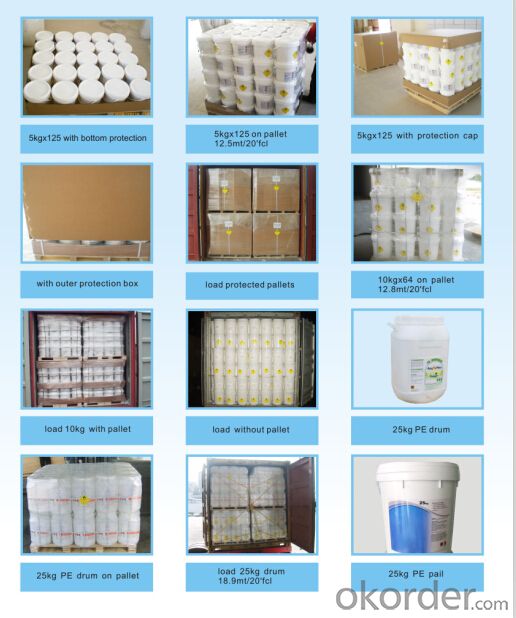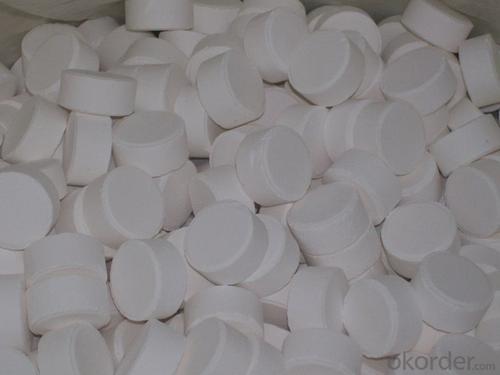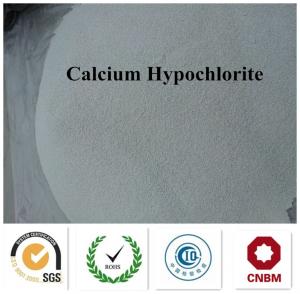Calcium Hypochlorite Granular Used For Water treatment
- Loading Port:
- Tianjin
- Payment Terms:
- TT OR LC
- Min Order Qty:
- 25 m.t.
- Supply Capability:
- 2000 m.t./month
OKorder Service Pledge
OKorder Financial Service
You Might Also Like
Calcium Hypochlorite
Introduction:
CNBM GROUP is the biggest water Treatment Factory in China. Our Product include: Calcium Hypochlorite, TCCA, SDIC, PAC, Sodium Sulphite, Sodium Thiosulfate etc.
CNBM One year can produce 18,000MT Calcium Hypochlorite with two model, one is 65% and one is 70%. More important we have 3 advantages, Firstly: High effective chlorine content Secondly: Good stability. Can be stored a long time at normal temperature with little chlorine loss; Third:Good solubility, less water-insoluble matters.
Technical Specifications:
Tablets Forms
Weight | 200 gram | 150gram | 100gram | 50gram | 30gram | 20gram | 15gram | 10gram |
Diameter(mm) | 76 | 70 | 50 | 42 | 30 | 30 | 30 | 30 |
Height(mm) | 25 | 21 | 26 | 27 | 22 | 16 | 12 | 8 |


Cautions
1. Should be stored in cool and dry warehouse away from heating sources and avoid direct sunlight.
2. In transportation, contact with such should be avoided as sunlight, heating,moisture, organics, oil and acids.
Other Information please check the MSDS.
4. Package:
Calcium Hypochlorite is packed in 10kgs,25kgs,40kgs,45kgs,50kgs plastic drums or 50kgs iron drums with PVC plastic bag
18MT-23.625MT will be loaded in 1*20’fcl container.
5. Instruction:
a) 100Kg 65% bleaching powder added to one ton water can be confected into bleaching solution with 6.5% effective chlorine content.
b) Adding 1.7g bleaching powder into one ton water can be confected into disinfectant fluid with a million to one effective chlorine content.
6. Advantages of our products:
a)High effective chlorine content
b)Particularly good stability, can be stored for long time under normal temperature, little efficiency content loss
c)High solubility, easily dissolve in water to form high concentrate bleaching solution with little undissolved substance
7. Attention and Storage:
Calcium Hypochlorite is a strong oxidant. Should be stored in dry, cool and ventilated place; avoid insolation, fire and heat; do keep it from mixing with organic substances, acids ,oil or reducing agents.when the package is broken and scatters, fast collecting and airproofing the product in time, if the skin be touched with it ,fast washing with diluted ammonia solution.
8. Fire Fighting:
Put out a fire with yellow sand, carbon dioxide and foam, don’t use ordinary vitriol fire extinguisher
- Q: Why is the residue after burning known as coarse ash? And inorganic salt content What is the difference
- There is no essential difference, the measurement method is different, so the result is different, the former is the burning method, which is the chemical method or instrument method
- Q: What is the time when the maximum number of inorganic salts is needed
- Plant inorganic salts are the most nitrogen, phosphorus and potassium containing inorganic salts, if any lack of plant will affect the normal growth.
- Q: Octopus why the lack of boron-containing inorganic salts can cause rape to flow only without fruit
- Boron has a great influence on the reproductive process of plants, which can accelerate pollen differentiation and pollen tube elongation. In the absence of boron, pollen tube germination is affected, poor fertilization, which leads to the formation of seeds affected, the reduction of growth hormone produced by the reduction of growth hormone will affect the formation of fruit.
- Q: What are the important physiological effects of inorganic salts in cells
- Composition of cells in some important compounds,
- Q: Does the plant absorb some of the inorganic salt?
- Plants absorb moisture through the infiltration of root cells to absorb moisture, the process is essentially a free diffusion of water, neither the carrier nor the need for energy;
- Q: What are the important physiological functions of inorganic salts in cells
- As a result of metabolism, every day a certain amount of inorganic salts from a variety of ways out of the body, which will be added through the diet. The metabolism of inorganic salts can be judged by analyzing the concentration of blood, hair, urine or tissue. The role of inorganic salts in the human body is interrelated. In the appropriate concentration range beneficial to the health of people and animals and plants, lack or too much can cause disease, and disease and affect its metabolism, often increase its consumption. In China, the lack of calcium, iron and iodine is more common. Selenium, fluoride and other geochemical environment with the different, both the lack of disease such as Keshan disease and Kashin-Beck disease, teeth, etc., there are too many diseases such as fluorosis and selenium poisoning.
- Q: Cells are composed of water and inorganic salts or by organic matter and none
- There are also organic matter such as protein and lipid
- Q: Think about the physical and chemical properties of salt and sugar. What properties do these substances have in common? Describe which properties you could use to distinguish between them. What properties and units would you use to describe their physical and chemical characteristics? List as many as you can.
- Salt: inorganic, ionic bond, soluble in water (ionizes); forms a crystal lattice structure as a solid. Sugar: organic compound, mostly covalent bonds, also soluble in water but does not ionize, can be burned, tastes good (just kidding).
- Q: what is the function of salts in DNA extraction?
- The role of the salt is to neutralize the charge of the DNA's sugar phosphate backbone. This makes the DNA less hydrophilic (less soluble in water). Ethanol has a lower dielectric constant than water so it's used to promote ionic bonds between the Na+ (from the salt) and the PO3- (from the DNA backbone) causing the DNA to precipitate, to extract DNA finally..
- Q: I am a candidate for this year's Harbin City, Jiqiu the standard answer, tomorrow I will test !!!
- Due to the metabolism, every day a certain amount of inorganic salts from a variety of ways excreted, and thus must be supplemented by dietary supplement. The metabolism of inorganic salts can be judged by analyzing the concentration of blood, hair, urine or tissue. The role of inorganic salts in the human body is interrelated. In the appropriate concentration range beneficial to the health of people and animals and plants, lack or too much can cause disease, and disease and affect its metabolism, often increase its consumption. In China, the lack of calcium, iron and iodine is more common. Selenium, fluoride and other geochemical environment with the different, both the lack of disease such as Keshan disease and Kashin-Beck disease, teeth, etc., there are too many diseases such as fluorosis and selenium poisoning.
Send your message to us
Calcium Hypochlorite Granular Used For Water treatment
- Loading Port:
- Tianjin
- Payment Terms:
- TT OR LC
- Min Order Qty:
- 25 m.t.
- Supply Capability:
- 2000 m.t./month
OKorder Service Pledge
OKorder Financial Service
Similar products
Hot products
Hot Searches
Related keywords






























